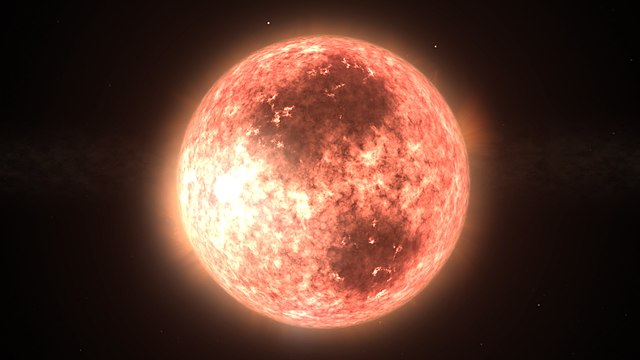A red dwarf is the smallest kind of star on the main sequence. Red dwarfs are by far the most common type of fusing star in the Milky Way, at least in the neighborhood of the Sun. However, due to their low luminosity, individual red dwarfs cannot be easily observed. From Earth, not one star that fits the stricter definitions of a red dwarf is visible to the naked eye. Proxima Centauri, the star nearest to the Sun, is a red dwarf, as are fifty of the sixty nearest stars. According to some estimates, red dwarfs make up three-quarters of the fusing stars in the Milky Way.
Proxima Centauri, the closest star to the Sun, at a distance of 4.2 ly (1.3 pc), is a red dwarf.
Gliese 623 is a pair of red dwarfs, with GJ 623a on the left and the fainter GJ 623b to the right of center.
Illustration depicting AU Mic, an M-type (spectral class M1Ve) red dwarf star less than 0.7% the age of the Sun. The dark areas represent huge sunspot-like regions.
An artist's impression of a planet with two exomoons orbiting in the habitable zone of a red dwarf.
In astronomy, the main sequence is a classification of stars which appear on plots of stellar color versus brightness as a continuous and distinctive band. Stars on this band are known as main-sequence stars or dwarf stars, and positions of stars on and off the band are believed to indicate their physical properties, as well as their progress through several types of star life-cycles. These are the most numerous true stars in the universe and include the Sun. Color-magnitude plots are known as Hertzsprung–Russell diagrams after Ejnar Hertzsprung and Henry Norris Russell.
Hot and brilliant O-type main-sequence stars in star-forming regions. These are all regions of star formation that contain many hot young stars including several bright stars of spectral type O.
The Sun is the most familiar example of a main-sequence star






